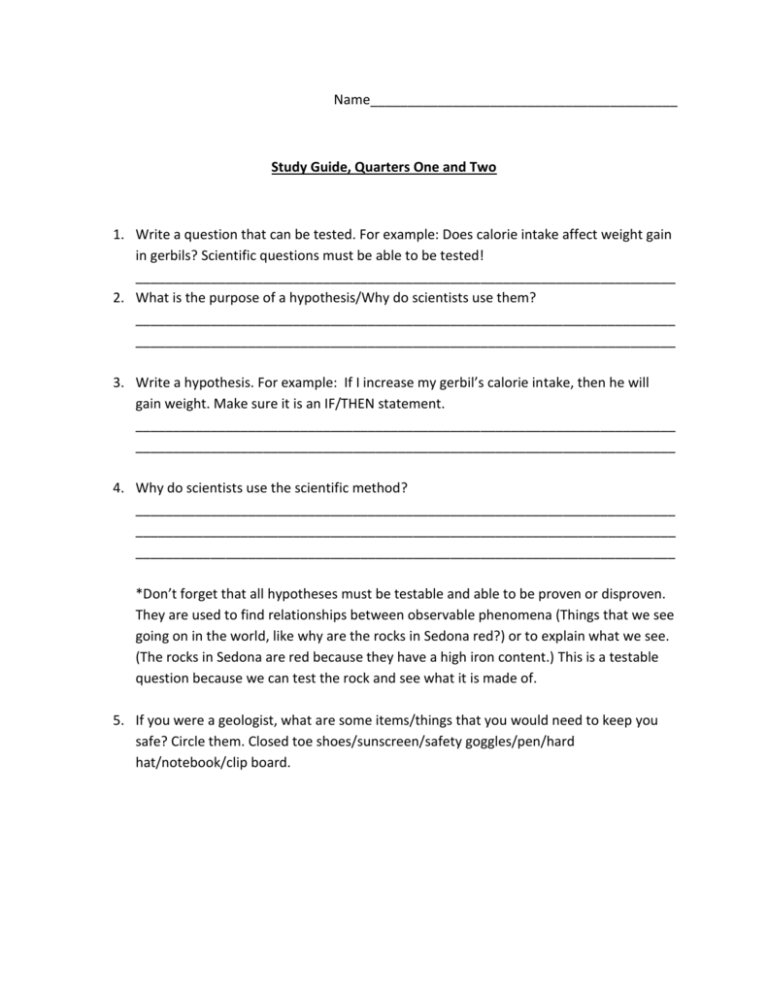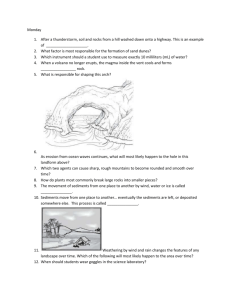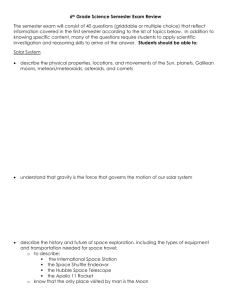Earth History
advertisement

Name_________________________________________ Study Guide, Quarters One and Two 1. Write a question that can be tested. For example: Does calorie intake affect weight gain in gerbils? Scientific questions must be able to be tested! ________________________________________________________________________ 2. What is the purpose of a hypothesis/Why do scientists use them? ________________________________________________________________________ ________________________________________________________________________ 3. Write a hypothesis. For example: If I increase my gerbil’s calorie intake, then he will gain weight. Make sure it is an IF/THEN statement. ________________________________________________________________________ ________________________________________________________________________ 4. Why do scientists use the scientific method? ________________________________________________________________________ ________________________________________________________________________ ________________________________________________________________________ *Don’t forget that all hypotheses must be testable and able to be proven or disproven. They are used to find relationships between observable phenomena (Things that we see going on in the world, like why are the rocks in Sedona red?) or to explain what we see. (The rocks in Sedona are red because they have a high iron content.) This is a testable question because we can test the rock and see what it is made of. 5. If you were a geologist, what are some items/things that you would need to keep you safe? Circle them. Closed toe shoes/sunscreen/safety goggles/pen/hard hat/notebook/clip board. o o o o fingernail (hardness = 2.5) copper penny (hardness = 3) glass plate or steel knife (hardness = 5.5) steel file (hardness = 6.5) 6. A mineral will scratch topaz. What number must the mineral be at the least? ________________________________________________________________________ 7. A mineral can be scratched by quartz, but the same mineral will scratch calcite. What numbers must this mineral be between? ________________________________________________________________________ 8. Based on the above information, is this true? A penny will scratch gypsum, but not fluorite. Yes/no_____________ Why? _________________________________________ 9. Minerals that are above an 8 on the hardness scale, colorful and rare are called what? ________________________________________________________________________ 10. Define: Alloy____________________________________________________________________ Ore_____________________________________________________________________ Gemstone_______________________________________________________________ 11. What are the following and what do they measure? (Mass, length, etc) Triple beam balance_______________________________________________________ Graduated cylinder________________________________________________________ Beaker__________________________________________________________________ Spring scale______________________________________________________________ 12. What do the following stand for & what do they measure? (length, weight, mass, volume?) mL_____________________________________________________________________ m______________________________________________________________________ mm_____________________________________________________________________ g_______________________________________________________________________ 13. Describe the following rocks/minerals and tell if they are a rock or mineral. Obsidian_________________________________________________________________ Quartz__________________________________________________________________ Coal____________________________________________________________________ Magnetite_______________________________________________________________ 14. Describe the following: Foliated: A rock that has a layered structure. Foliated metamorphic______________________________________________________ Intrusive igneous__________________________________________________________ Extrusive igneous__________________________________________________________ *What type of the above rocks will have large grains due to slow underground cooling? ________________________________________________________________________ 15. How does the rate of cooling affect the size of the grains? Faster cooling=less time for the grains to form. (Think back to the crystals we grew in class and how fast they grew based on how quickly they cooled.) Intrusive_________________________________________________________________ Extrusive________________________________________________________________ 16. Explain how the following rocks are formed: Sedimentary_____________________________________________________________ Igneous _________________________________________________________________ Metamorphic____________________________________________________________ Don’t forget the rules below: THE LAW OF ORIGINAL HORIZONTALITY This law of science tells us that dirt, mud, sand and other sediments are almost always deposited in horizontal layers. As these sediments stack up, they often harden, forming rock layers. THE LAW OF SUPERPOSITION Rock layers are usually ordered with the oldest layers on the bottom, and the most recent layers on top. The Law of Faunal Succession explains that fossils found in rock layers are also ordered in this way. 17. What layer was deposited first? Top/middle/bottom? (Circle one) How do you know this? ________________________________________________________________________ ________________________________________________________________________ 18. If there was a volcanic eruption between two of the above layers, what would that do to the rocks and the fossil record? ________________________________________________________________________ ________________________________________________________________________ 19. What would that eruption do the climate and the organisms living on the surface of the Earth? ________________________________________________________________________ ________________________________________________________________________ 20. Describe the layers of the Earth: Crust___________________________________________________________________ Mantle__________________________________________________________________ Inner core _______________________________________________________________ Outer core_______________________________________________________________ Lithosphere______________________________________________________________ Asthenosphere___________________________________________________________ 21. Compare and contrast the components of earth's inner and outer cores. Inner core_______________________________________________________________ Outer core_______________________________________________________________ 22. Identify the stages of erosion and deposition. Define the following: Weathering______________________________________________________________ Erosion__________________________________________________________________ Transportation____________________________________________________________ Deposition_______________________________________________________________ 23. Identify how plants affect the rate of erosion. Do they slow it down or speed it up? Why? ________________________________________________________________________ _______________________________________________________________________ 24. Describe what is going on in this picture. Remember, convection drives the movements of plates. ________________________________________________________________________ ________________________________________________________________________ ________________________________________________________________________ Where do convection currents occur? _______________________________________________ 25. . How could erosion affect the fossil record? ________________________________________________________________________ ________________________________________________________________________ 26. When scientists study fossil records, they see that tropical fossils can be found in nontropical environments. How can this happen? ________________________________________________________________________ ________________________________________________________________________ 27. Why do plates in the lithosphere move? ________________________________________________________________________ _______________________________________________________________________ Label the pictures with the proper plate movement. 28. What evidence did scientists like Wegner have that the plates moved? ________________________________________________________________________ ________________________________________________________________________ ________________________________________________________________________ *Hint-fossils, rock layers, sea floor 29. Identify/describe these types of volcanoes based on how they are formed. Cinder__________________________________________________________________ _______________________________________________________________________ Shield___________________________________________________________________ _______________________________________________________________________ Composite_______________________________________________________________ _______________________________________________________________________ 30. Define the following things related to earthquakes: Describe the waves, which one is fastest and what they travel through: P Wave__________________________________________________________________ S Wave__________________________________________________________________ Surface Wave_____________________________________________________________ Seismograph_____________________________________________________________ Richter scale_____________________________________________________________ What does a seismograph measure __________________________________________ What is this?__________________________________________ 31. How does plate movement affect the following landforms? How does the movements of the plates make these landforms? Folded mountains_________________________________________________________ Faults___________________________________________________________________ Rift Valleys_______________________________________________________________ Volcanoes_______________________________________________________________ Deep oceanic trench_______________________________________________________ 32. What type of plate movement formed the Himalayas? __________________________________ Hint: Ocean-ocean? Ocean-continent? Continent-continent?






